-
 Bitcoin
Bitcoin $117700
-1.00% -
 Ethereum
Ethereum $4458
-3.91% -
 XRP
XRP $3.119
0.14% -
 Tether USDt
Tether USDt $1.001
-0.02% -
 BNB
BNB $836.6
-1.56% -
 Solana
Solana $189.5
-3.90% -
 USDC
USDC $0.9998
-0.02% -
 Dogecoin
Dogecoin $0.2335
1.29% -
 Cardano
Cardano $0.9642
1.51% -
 TRON
TRON $0.3539
-1.19% -
 Hyperliquid
Hyperliquid $47.41
-1.84% -
 Chainlink
Chainlink $21.92
-3.28% -
 Stellar
Stellar $0.4286
-0.23% -
 Sui
Sui $3.724
-3.29% -
 Bitcoin Cash
Bitcoin Cash $594.8
-0.78% -
 Ethena USDe
Ethena USDe $1.001
0.04% -
 Hedera
Hedera $0.2501
-2.06% -
 Avalanche
Avalanche $23.96
-4.87% -
 Litecoin
Litecoin $119.0
-2.32% -
 Toncoin
Toncoin $3.473
0.82% -
 UNUS SED LEO
UNUS SED LEO $9.596
0.17% -
 Shiba Inu
Shiba Inu $0.00001301
-0.39% -
 Uniswap
Uniswap $11.03
-0.25% -
 Polkadot
Polkadot $3.935
-2.62% -
 Dai
Dai $1.000
0.01% -
 Bitget Token
Bitget Token $4.564
-1.76% -
 Cronos
Cronos $0.1512
-4.11% -
 Ethena
Ethena $0.7306
-1.09% -
 Pepe
Pepe $0.00001087
-2.68% -
 Aave
Aave $300.2
-4.00%
What is the blockchain impossible triangle? Why do all projects have to make trade-offs?
Blockchain projects face the trilemma of balancing scalability, security, and decentralization, often requiring trade-offs to function effectively.
Apr 09, 2025 at 09:07 pm
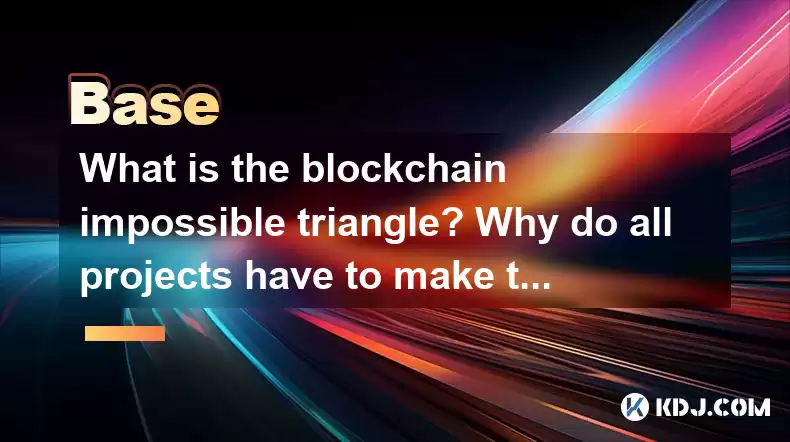
The concept of the blockchain impossible triangle, often referred to as the blockchain trilemma, is a fundamental challenge that all blockchain projects face. This triangle consists of three key attributes: scalability, security, and decentralization. The premise of the blockchain impossible triangle is that it is extremely difficult, if not impossible, for a blockchain system to achieve optimal levels of all three attributes simultaneously. As a result, all blockchain projects must make trade-offs between these three elements to function effectively.
Understanding Scalability
Scalability refers to a blockchain's ability to handle a growing amount of work and its potential to accommodate growth. A highly scalable blockchain can process a large number of transactions per second (TPS) and can grow to support more users and applications without compromising performance. However, increasing scalability often requires compromises in other areas, such as security or decentralization. For instance, to achieve higher transaction throughput, some blockchains may increase block sizes or reduce the time between blocks, which can lead to centralization as fewer nodes are able to keep up with the network's demands.
Exploring Security
Security is another critical component of the blockchain impossible triangle. It pertains to the robustness of the network against attacks and the integrity of the data stored on the blockchain. A secure blockchain ensures that transactions are valid and that the network is resistant to malicious activities such as double-spending or 51% attacks. Enhancing security often involves increasing the computational power required to validate transactions, which can lead to slower transaction times and reduced scalability. Additionally, a highly secure blockchain may require more nodes to participate in the validation process, which can impact decentralization.
Examining Decentralization
Decentralization is the third element of the blockchain impossible triangle. It refers to the distribution of control and decision-making across the network, rather than being concentrated in the hands of a few entities. A highly decentralized blockchain is less susceptible to censorship and single points of failure, but achieving high levels of decentralization can be challenging. More nodes participating in the network can slow down transaction processing and increase the resources required to maintain the network, thus affecting scalability. Moreover, a highly decentralized network may be more vulnerable to certain types of attacks, impacting security.
Trade-offs in Blockchain Projects
Given the constraints of the blockchain impossible triangle, all blockchain projects must make trade-offs to balance scalability, security, and decentralization. For example, Bitcoin, the first and most well-known blockchain, prioritizes security and decentralization over scalability. Its block size limit and the time it takes to mine a block result in a relatively low transaction throughput, which can lead to congestion and high transaction fees during peak times.
On the other hand, some newer blockchains, such as Ethereum 2.0, are attempting to improve scalability while maintaining a high level of security and decentralization. Ethereum 2.0 introduces sharding, a technique that allows the network to process multiple transactions in parallel, thereby increasing its capacity. However, implementing sharding is complex and requires careful consideration to ensure that it does not compromise the network's security or decentralization.
Examples of Trade-offs in Popular Blockchains
To illustrate the trade-offs that blockchain projects must make, let's look at a few examples:
Bitcoin: As mentioned earlier, Bitcoin prioritizes security and decentralization. Its proof-of-work consensus mechanism requires significant computational power, which contributes to its security but also results in slower transaction times and lower scalability. Bitcoin's decentralized nature is maintained by allowing anyone to run a node and participate in the network, but this can lead to slower consensus and higher energy consumption.
Ethereum: Ethereum, like Bitcoin, uses a proof-of-work consensus mechanism, but it has a higher transaction throughput due to its smaller block time. However, Ethereum still faces scalability issues, which are being addressed through the transition to Ethereum 2.0. The move to a proof-of-stake consensus mechanism aims to improve scalability and reduce energy consumption while maintaining security and decentralization.
Solana: Solana is known for its high scalability, capable of processing thousands of transactions per second. It achieves this through a combination of proof-of-history and proof-of-stake consensus mechanisms. However, some critics argue that Solana's high throughput comes at the cost of decentralization, as the network relies on a smaller number of validators compared to more decentralized networks like Bitcoin.
The Importance of Trade-offs
Understanding the blockchain impossible triangle and the necessity of trade-offs is crucial for anyone involved in the cryptocurrency space. Whether you are a developer building a new blockchain, an investor evaluating different projects, or a user choosing which blockchain to use, recognizing the inherent limitations and compromises is essential. Each blockchain project's approach to balancing scalability, security, and decentralization will determine its suitability for different use cases and its overall success in the market.
FAQs
Q: Can a blockchain project achieve perfect balance in the impossible triangle?
A: Achieving a perfect balance in the blockchain impossible triangle is highly unlikely due to the inherent trade-offs between scalability, security, and decentralization. While some projects may come closer to achieving a balance than others, all must make compromises to some extent.
Q: How do different consensus mechanisms affect the blockchain impossible triangle?
A: Different consensus mechanisms, such as proof-of-work, proof-of-stake, and delegated proof-of-stake, have varying impacts on the blockchain impossible triangle. Proof-of-work, for example, tends to prioritize security and decentralization but can limit scalability. Proof-of-stake, on the other hand, can improve scalability and reduce energy consumption but may face challenges in maintaining the same level of decentralization.
Q: Are there any emerging technologies that could help solve the blockchain impossible triangle?
A: Several emerging technologies, such as sharding, layer-2 scaling solutions, and zero-knowledge proofs, are being explored to address the challenges posed by the blockchain impossible triangle. These technologies aim to improve scalability without compromising security or decentralization, but their effectiveness and long-term impact are still being evaluated.
Q: How do users and developers perceive the trade-offs in the blockchain impossible triangle?
A: Users and developers often have different priorities when it comes to the blockchain impossible triangle. Users may prioritize scalability for faster and cheaper transactions, while developers may focus on security and decentralization to ensure the integrity and resilience of the network. Understanding these differing perspectives is important for blockchain projects to meet the needs of their community.
Disclaimer:info@kdj.com
The information provided is not trading advice. kdj.com does not assume any responsibility for any investments made based on the information provided in this article. Cryptocurrencies are highly volatile and it is highly recommended that you invest with caution after thorough research!
If you believe that the content used on this website infringes your copyright, please contact us immediately (info@kdj.com) and we will delete it promptly.
- Kazakhstan's Crypto Leap: Bitcoin ETF and Central Asia's Digital Finance Future
- 2025-08-13 12:45:19
- BlockDAG Presale Blazes Past $371M: Fundraising Frenzy Fuels Crypto Sensation
- 2025-08-13 13:05:21
- Meme Coins: Chasing the 2025 Surge – Which Will Moonshot?
- 2025-08-13 10:25:23
- Bitcoin's Wild Ride: Rally, Pullback, and What's Next
- 2025-08-13 10:25:23
- Bitcoin, Bitmax, and Institutional Demand: A New Era of Crypto Investment
- 2025-08-13 10:45:12
- Solana, ROAM, and Airdrops: What's the Buzz in 2025?
- 2025-08-13 11:35:13
Related knowledge
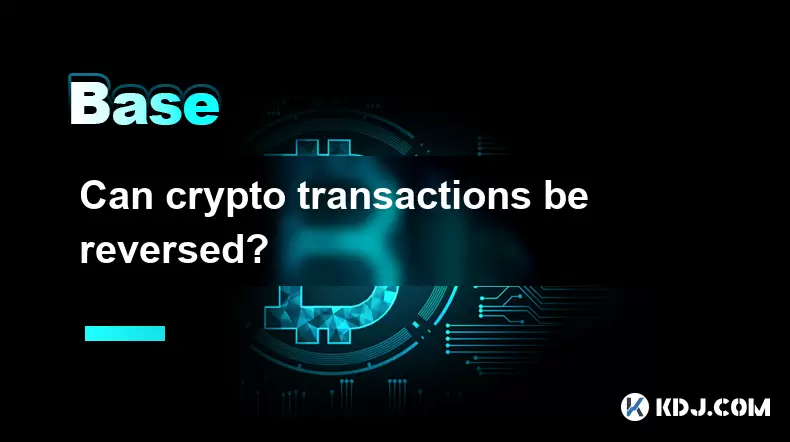
Can crypto transactions be reversed?
Aug 10,2025 at 01:35am
Understanding the Immutability of Blockchain TransactionsCryptocurrency transactions are built on blockchain technology, which is designed to be immut...
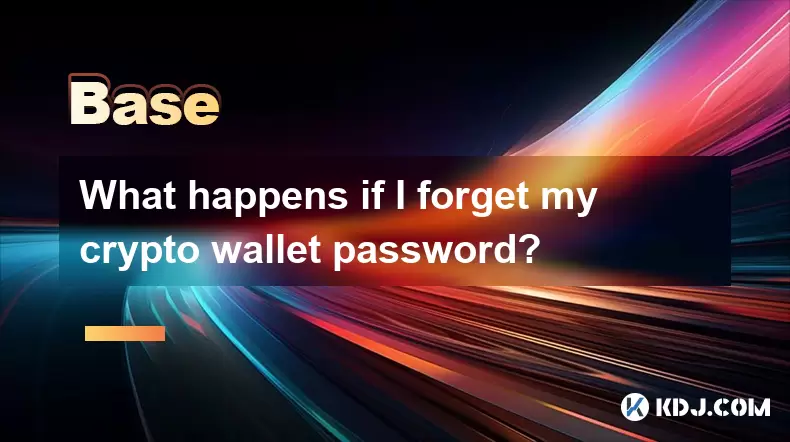
What happens if I forget my crypto wallet password?
Aug 09,2025 at 08:50am
Understanding the Role of a Crypto Wallet PasswordA crypto wallet password serves as a critical security layer that protects access to your digital as...
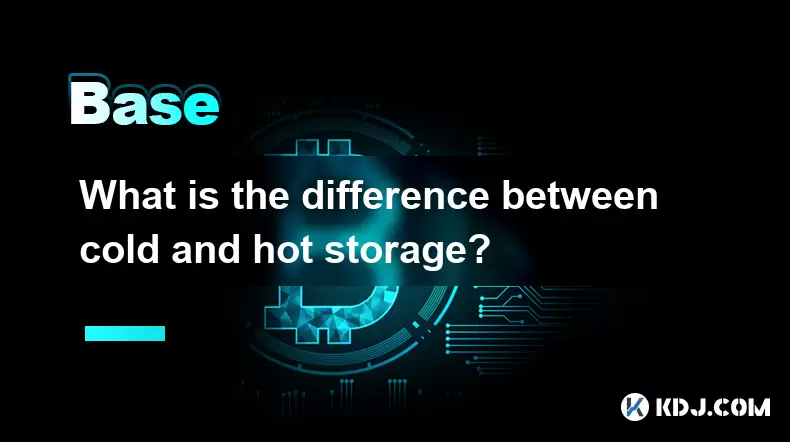
What is the difference between cold and hot storage?
Aug 12,2025 at 01:01am
Understanding Cold Storage in CryptocurrencyCold storage refers to offline methods of storing cryptocurrency private keys, ensuring they are not expos...
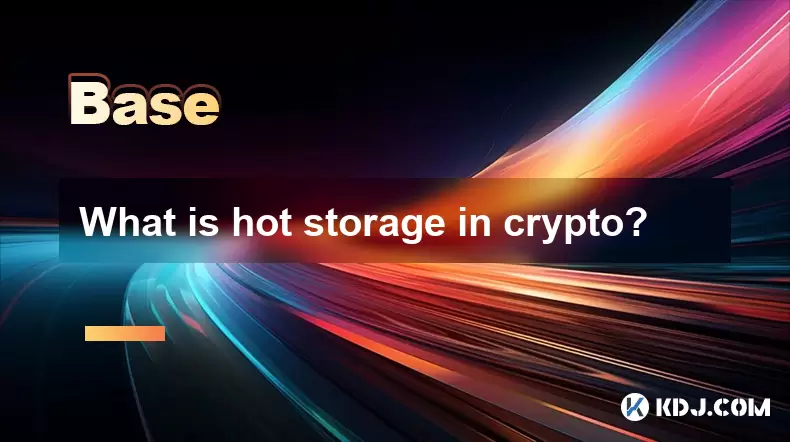
What is hot storage in crypto?
Aug 11,2025 at 07:08am
Understanding Hot Storage in CryptocurrencyHot storage refers to cryptocurrency wallets that are connected to the internet. Unlike cold storage soluti...

What is cold storage in crypto?
Aug 13,2025 at 11:35am
Understanding Cold Storage in CryptocurrencyCold storage in cryptocurrency refers to a method of storing digital assets offline, away from internet-co...

What is the best crypto portfolio tracker?
Aug 10,2025 at 05:08am
Understanding the Role of a Crypto Portfolio TrackerA crypto portfolio tracker is a digital tool designed to help investors monitor the performance of...

Can crypto transactions be reversed?
Aug 10,2025 at 01:35am
Understanding the Immutability of Blockchain TransactionsCryptocurrency transactions are built on blockchain technology, which is designed to be immut...

What happens if I forget my crypto wallet password?
Aug 09,2025 at 08:50am
Understanding the Role of a Crypto Wallet PasswordA crypto wallet password serves as a critical security layer that protects access to your digital as...

What is the difference between cold and hot storage?
Aug 12,2025 at 01:01am
Understanding Cold Storage in CryptocurrencyCold storage refers to offline methods of storing cryptocurrency private keys, ensuring they are not expos...

What is hot storage in crypto?
Aug 11,2025 at 07:08am
Understanding Hot Storage in CryptocurrencyHot storage refers to cryptocurrency wallets that are connected to the internet. Unlike cold storage soluti...

What is cold storage in crypto?
Aug 13,2025 at 11:35am
Understanding Cold Storage in CryptocurrencyCold storage in cryptocurrency refers to a method of storing digital assets offline, away from internet-co...

What is the best crypto portfolio tracker?
Aug 10,2025 at 05:08am
Understanding the Role of a Crypto Portfolio TrackerA crypto portfolio tracker is a digital tool designed to help investors monitor the performance of...
See all articles

























































































